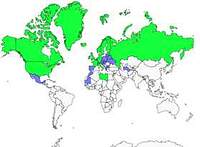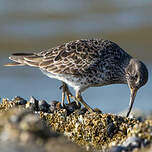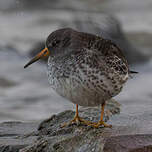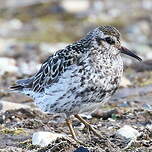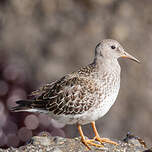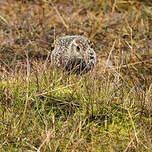Purple Sandpiper
Calidris maritima - Bécasseau violet
Identification
The Purple Sandpiper is a stocky medium-sized sandpiper with dark plumage, a long orange-based bill and short yellow legs. In breeding plumage, the upper plumage is dark brown with edgings ranging from white to red-brown through chamois, with the fringing gradually narrowing with wear. The brown crown is striped with the same colors. The underside is white, strongly marked with black arrow-shaped marks on the chest and flanks. The neck and throat are streaked with brown.
In winter, the plumage is uniformed, particularly on the head and neck, gray-brown. The mantle and the upper surfaces of the wings are the same shade. The mantle feathers have a slight edging while the wing covers give the impression of being covered with a white net. The eye ring and chin are white. The chest and flanks are spotted with black-brown. In flight, two characters are clearly visible: on the one hand, the narrow white wing bar of the base of the remiges that stands out particularly on the dark wings, and on the other hand, the two-color tail, with the two central rectrices black-brown like the rump, framed by the outer rectrices gray-light.
The juvenile resembles the nuptial adult without the warm shades and with the upper feathers bordered with white or light chamois giving a scaly appearance, particularly to the wing covers.
Subspecific information monotypic species
Foreign names
- Bécasseau violet,
- Correlimos oscuro,
- pilrito-escuro,
- Meerstrandläufer,
- tengeri partfutó,
- Paarse Strandloper,
- Piovanello violetto,
- skärsnäppa,
- Fjæreplytt,
- pobrežník morský,
- jespák mořský,
- Sortgrå Ryle,
- merisirri,
- territ fosc,
- Sendlingur,
- biegus morski,
- jūras šņibītis,
- morski prodnik,
- Морской песочник,
- ムラサキハマシギ,
- 紫滨鹬,
- skärsnäppa,
- 紫濱鷸,
Voice song and call
Habitat
In summer, the Purple Sandpiper frequents the tundra coasts of the High Arctic, but it is also present at high altitudes in the mountains as long as they are not too far from the coast, although its presence very further into the land is proven. In winter, it is exclusively maritime, typically frequenting rocky coasts, jetties and rock outcrops in the zone of tidal flows. It is never seen on the sand or mud. Its presence in estuaries is rare.
Behaviour character trait
Outside the winter period, the best time to observe the Purple Sandpiper is during the post-nuptial migration in October and November.
In the fall, Nordic populations migrate to nearby coastlines or further in South France (Brittany), Great Britain or North Spain, where they are sure to find favorable and abundant nourishing conditions. During the winter, the Purple Sandpipers are grouped together and couples are formed without any kind of display or demonstration. Yet, it seems the white underwing area is playing an important role in communication between individuals. Usually, the Purple Sandpiper is a rather confident bird. However, when it is in close vicinity of the Turnstones, it become more wary and more difficult to approach.Dietfeeding habits
He feeds a little bit like a turnstone, which he shares habits with and sometimes the company of. Thus, it is possible to see him on the rocky parts, by the waves, overturning tufts of algae or inspecting minutely the smallest crevices in search of marine invertebrates, such as small crustaceans, which the tide mobilizes.
Reproduction nesting
Geographic range
Threats - protection
IUCN conservation status
concern
in the Wild
threatened
evaluated
The Purple Sandpiper is not classified as an endangered species even though an established decline is reported, but no figures are provided. Its range is wide-spread. The ongoing climate changes could have an influence on the species dynamics.
Sources of information
- IOC World Bird List (v15.1), Gill, F and D Donsker (Eds). 2025-12-07.
- Shorebirds, an identification guide to the waders of the world, Peter Hayman, John Marchant Tony Prater
- BirdLife International, BirdLife International
- Birds of the World, The Cornell Lab of Ornithology
- HBW Alive,
- xeno-canto, Sharing bird sounds from around the world,
Other sources of interest
 Specification sheet created on
26/07/2023 by Jean François
Specification sheet created on
26/07/2023 by Jean FrançoisTranslation by AI Oiseaux.net
© 1996-2025 Oiseaux.net
- Accipitriformes
- Aegotheliformes
- Anseriformes
- Apodiformes
- Apterygiformes
- Bucerotiformes
- Caprimulgiformes
- Cariamiformes
- Casuariiformes
- Charadriiformes
- Ciconiiformes
- Coliiformes
- Columbiformes
- Coraciiformes
- Cuculiformes
- Eurypygiformes
- Falconiformes
- Galliformes
- Gaviiformes
- Gruiformes
- Leptosomiformes
- Mesitornithiformes
- Musophagiformes
- Nyctibiiformes
- Opisthocomiformes
- Otidiformes
- Passeriformes
- Pelecaniformes
- Phaethontiformes
- Phoenicopteriformes
- Piciformes
- Podargiformes
- Podicipediformes
- Procellariiformes
- Psittaciformes
- Pterocliformes
- Rheiformes
- Sphenisciformes
- Steatornithiformes
- Strigiformes
- Struthioniformes
- Suliformes
- Tinamiformes
- Trogoniformes


